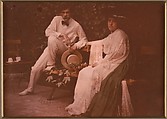Stieglitz and Emmy
Frank Eugene American
Not on view
Eugene's strong painting background and expertise in printing were patently evident in the Pictorialist photographs he made beginning about 1894. In 1902, Stieglitz invited him to become a founding member of the Photo-Secession, and his facility with complicated photographic techniques such as the gum bichromate and autochrome processes, as well as his refined aesthetic sensibility, matched the artistic ambitions of the group perfectly. One of the earliest color processes, the autochrome was not only difficult but time consuming, requiring several stages of development and careful registration alignments; the final product was a colored glass plate meant to be seen illuminated from behind. Despite its challenges, Eugene mastered it and used it often, as here in this luminous scene depicting the founder of the Photo-Secession with his daughter.
#5509. Stieglitz and Emmy
This image cannot be enlarged, viewed at full screen, or downloaded.
This artwork is meant to be viewed from right to left. Scroll left to view more.




